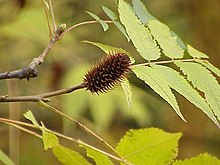Loading AI tools
Genus of flowering plants From Wikipedia, the free encyclopedia
Platycarya strobilacea is a species of flowering plant in the family Juglandaceae, formerly treated as comprising the single living species in Platycarya, though a second living species Platycarya longzhouensis is now recognized. It is native to eastern Asia in China, Vietnam, Korea, and Japan.[1][2]

| Platycarya strobilacea | |
|---|---|
 | |
| Autumn foliage and fruit | |
| Scientific classification | |
| Kingdom: | Plantae |
| Clade: | Tracheophytes |
| Clade: | Angiosperms |
| Clade: | Eudicots |
| Clade: | Rosids |
| Order: | Fagales |
| Family: | Juglandaceae |
| Genus: | Platycarya |
| Species: | P. strobilacea |
| Binomial name | |
| Platycarya strobilacea | |
It is a deciduous tree growing to 15 m tall. The leaves are usually pinnate, 15–30 cm long with 7–15 leaflets (rarely simple, or with up to 23 leaflets), the terminal leaflet present; the leaflets are 3–11 cm long and 1.5–3.5 cm broad. The flowers are catkins; the male (pollen) catkins are 2–15 cm long, the female catkins 2.5–5 cm long at maturity, hard and woody, superficially resembling a conifer cone with spirally arranged scales.[1][2] Galloyl pedunculagin can be found in P. strobilacea.[3]
Seamless Wikipedia browsing. On steroids.
Every time you click a link to Wikipedia, Wiktionary or Wikiquote in your browser's search results, it will show the modern Wikiwand interface.
Wikiwand extension is a five stars, simple, with minimum permission required to keep your browsing private, safe and transparent.